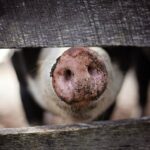A deer price to pay for inaction

Fallow deer are native to Iran and Iraq but were introduced to Europe in Roman times. They are the common park deer of England and were the first species of deer to
become established in Australia in the 19th century.
However deer, like other feral species such as foxes and rabbits, quickly bred in the wild and became a danger to both wilderness and agricultural areas. Feral deer destroy native vegetation, trample plants and ring-bark young trees. They foul waterholes, cause soil erosion, spread weeds and increase the potential for transmitting diseases such as foot-and-mouth disease.
Tasmania’s population of fallow deer has more than tripled since the 1970s and by 2023 is likely to increase by about 40%. It has been estimated that by mid-century the population could exceed one million.
In 2020 the Tasmanian Government released the results of an aerial survey of deer across the introduced animal’s core range within the state. The results put the number of feral deer in this area alone at 54,000 – the survey didn’t cover the Tasmanian Wilderness World Heritage Area, northwest of the state or down south and on Bruny Island. All areas known to have feral deer populations.
However the Rockliff government’s newly released Implementation Strategy for the Management of Fallow Deer has been criticised by the Invasive Species Council for failing to take the growing problem seriously.
‘The government is clearly underestimating the crisis in Tasmania. The strategy reads like a nice day out in the country rather than providing the systematic plan that’s needed to control feral deer,’ said Invasive Species Council CEO Andrew Cox.
‘Hunting is not an eradication plan. A reliance on recreational hunting is why we’re in the current situation with plagues of feral deer spreading across Tasmania.
‘If we carry on with business as usual, deer populations will spiral. By 2050, there will be up to a million deer, wreaking havoc on farms and national parks across half of Tasmania. We are facing a feral deer crisis, and we need professional, systematic control to address it,’ he said.
‘Feral deer devastate the environment, destroy farmlands and threaten our renowned national parks and world heritage areas.’
‘A failure to implement systematic control will threaten the Tasmanian Wilderness World Heritage Area and our national parks, as well as the livelihoods of tourism operators who rely on these natural attractions. We will see motorists at increased risk on the roads and farmers suffering economic losses,’ said Mr Cox.
The plan includes a pilot of aerial shooting in the World Heritage area and Walls of Jerusalem National Park but, without scaled up effort and utilising professional ground shooting, this won’t be enough to solve the problem.
‘Eradication is difficult and requires significant government investment. Only the most dedicated programs are successful,’ said Mr Cox.
‘Time is running out and urgent targeted action across the state is needed in our national parks, the World Heritage area and places such as King and Bruny islands and the Tasman Peninsula.
‘As our only island state, Tasmania has the opportunity to lead Australia as a state that treats feral animal and biosecurity threats seriously. The current government’s obsession with putting hunting interests ahead of sound biosecurity practice threatens a thriving future for Tasmania’s environment and the people who rely on it for their livelihoods,’ he said.
Open Forum is a policy discussion website produced by Global Access Partners – Australia’s Institute for Active Policy. We welcome contributions and invite you to submit a blog to the editor and follow us on Twitter, Facebook, Linkedin and Mastadon.













